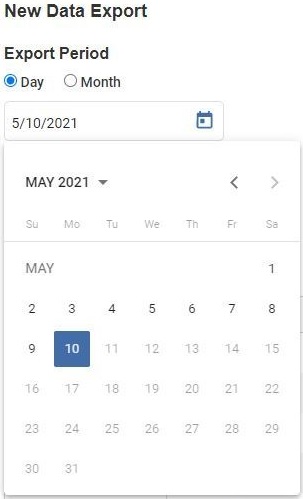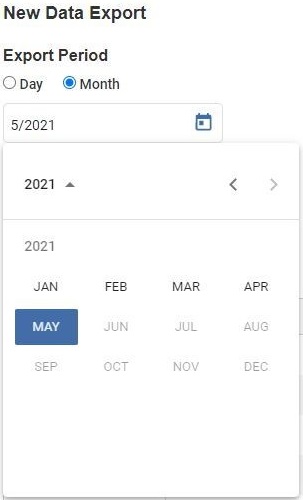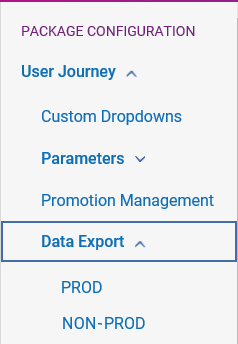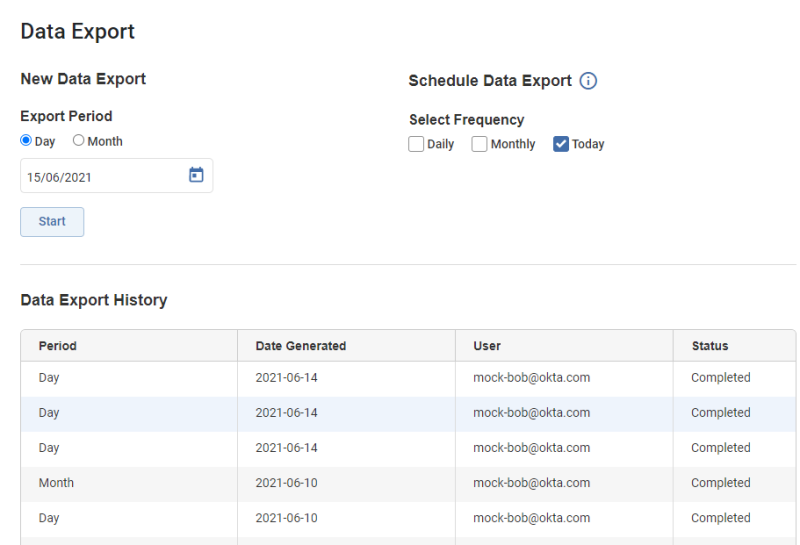Data export
Data export allows data from one or more tables in the client operational database (in all environments; non-prod or production) to be exported for client consumption, including the scenario where child tables are related to multiple parent tables in the data model. For example, a client could choose to export all the information in the table APPLICATION.
The data export service also includes a scheduling ability, which allows clients to configure a specific time or a recurring period (daily or monthly) to run a report.
To access data export
- On the homepage, click the Administration tile to access the Administration functionality.
- Click the appropriate Package Configuration drop down in the left-hand panel.
- Select Data Export.
- Select the chosen environment from the Data Export drop down.
- This will open the Data Export page allowing you to trigger data export for a chosen period or schedule future data exports. This page will also contain a Data Export History table which displays a list of historical exported data sets.
-
In the New Data Export panel, select the data export period in the Export Period field and click Start. The export period options are:
- Day - exports the data for a chosen day. Click the calendar icon, scroll to the chosen month by clicking the arrow icons (<>) and select the day you require. The date for a chosen day can also be entered manually in the calendar field, using the format
DD/MM/YYYY. - Month - exports the data for a chosen month. The date for a chosen month can also be entered manually in the calendar field, using the format
MM/YYYY.


If a file is exported successfully, the message Data export triggered successfully will be displayed. The following table lists the other possible messages returned by the system.
Message type Message Notes Success Data export triggered successfully. Validation/warning An export is currently running. Please try again later. The export has been triggered before a previous export has finished processing. The status of the processed files will also be displayed in the Data Export History table. Data exports that are manually selected for a period (rather than scheduled exports) will display either, Day or Month in the Period column. Data export dates are validated in the user interface and validation messages are displayed if a date fails validation for the following reasons:
- Dates before 01/01/1970 are invalid (refers to Export Period = Day)
- Dates before 01/1970 are invalid (refers to Export Period = Month)
- Future dates are not allowed
- Invalid date format
- Export period date required (refers to Export Period = Day)
- Export period month required (refers to Export Period = Month)

- Day - exports the data for a chosen day. Click the calendar icon, scroll to the chosen month by clicking the arrow icons (<>) and select the day you require. The date for a chosen day can also be entered manually in the calendar field, using the format
-
In the Schedule Data Export panel, the data export frequency can be scheduled by using the Select Frequency checkboxes. The export frequency options are:
- Daily - exports the data daily (the default schedule is daily at 01:00 UTC time)
- Monthly - exports the data for the previous month (the default schedule is the first day of every month at 03:00 UTC time)
- Today - exports the data for the current day (the default schedule is daily at 18:00 UTC time)


| Data export time periods and schedules are programmed to use UTC time. |
To download an exported file
Files returned using the Data Export functionality can be accessed by using either the Secure Transport Service or using a third party SFTP client.
Output file format
| Description | Files returned from Experian |
|---|---|
| File naming convention | Data export - [type of export]_[period of exported content]_[table name]_[creation date&time of export].zip |
| File format | File will be returned in zipped CSV format. |
| CSV format | Files returned are b64 encoded, with row number from the input file and b64 encoded BPS response. Example data export CSV file |
| Ascii/Binary | Binary, as the files will be returned in a zipped CSV format. |
| Exported files can be accessed by logging in to the Secure Transport Service. |
Exported files have the following naming conventions:[type of export]_[period of exported content]_[table name]_[creation date&time of export].zipThe hours in the filename are in 24-hour format. Exporting a specific day - the filename starts with the type of export followed by the date (YYYY-MM-DD) of the exported content.Data Export example Day_2020-01-25_application_2020-10-02-13-28-35.zipScheduled Data Export example Daily_Scheduled_2020-01-25_application_2020-01-26-13-28-35.zipExporting a specific month - the filename starts with the type of export followed by the date (YYYY-MM) of the exported content.Data Export example Month_2020-01_application_2020-10-02-13-28-35.zipScheduled Data Export example Monthly_Scheduled_2020-01_application_2020-02-01-13-28-35.zipA scheduled date export for Today - the filename starts with the type of export followed by the date (YYYY-MM-DD) of the exported content. For exampleToday_Scheduled_2020-01-25_application_2020-01-25-13-28-35.zipThe date of creation is generated when the file creation process is triggered. |
|
The Data Export Service has the capability to transform exported data. A Groovy script configured to transform (part or all of) the exported data can be executed before the generation of the exported zipped csv file. If the groovy script is applied to the data, the output is transformed. If not, the data is exported as it is in the database. This functionality is controlled using a property (values: on, off). It is set to off by default. The Groovy script also allows you to define:
|
|
A line feed character (line break character) is available for output files defined by the following property:
LF corresponds to the client requirements for a line feed character, no changes regarding this property are expected.
|